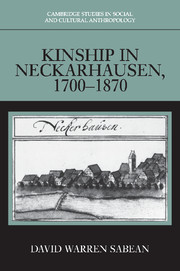Book contents
- Frontmatter
- Contents
- List of tables
- Abbreviations
- Abbreviations of sources
- On reading kinship diagrams
- Glossary
- Preface
- Introduction
- Cohort I (1700–1709)
- Cohort II (1740–1749)
- Cohort III (1780–1789)
- Cohort IV (1820–1829)
- Cohort V (1860–1869)
- 17 Kinship in the mid-nineteenth-century village: An introduction
- 18 Networking with kin around the mid nineteenth century
- 19 Matrifocal alliance
- Conclusion
- Appendix
- Bibliography
- General index
- Index of villagers
17 - Kinship in the mid-nineteenth-century village: An introduction
Published online by Cambridge University Press: 04 August 2010
- Frontmatter
- Contents
- List of tables
- Abbreviations
- Abbreviations of sources
- On reading kinship diagrams
- Glossary
- Preface
- Introduction
- Cohort I (1700–1709)
- Cohort II (1740–1749)
- Cohort III (1780–1789)
- Cohort IV (1820–1829)
- Cohort V (1860–1869)
- 17 Kinship in the mid-nineteenth-century village: An introduction
- 18 Networking with kin around the mid nineteenth century
- 19 Matrifocal alliance
- Conclusion
- Appendix
- Bibliography
- General index
- Index of villagers
Summary
By the 1830s the structural changes associated with the agricultural revolution were well in place. Stall feeding had clearly triumphed and the village had reorganized and intensified its pasture and meadowland. The fallow field was largely planted to fodder crops, and the production of potatoes had risen considerably. Root and fodder crops involved long hours of careful hoeing, carried out for the most part by women. They continually harvested green fodder crops and grass throughout the summer and carried them in hay kerchiefs on their heads from the fields to the stalls in the village. The 1830s were years of intensive flax cultivation, preparation, and spinning – all tasks in which women were predominant. During the previous two decades a new emphasis had been placed on having sufficient firewood for washing day, another aspect in the revision and reorganization of women's work during the period. An ideal of cleanliness and housewifery had developed in the village precisely at the time when women were being drawn into agriculture in a massive way.
I have suggested in Volume I that the intensified production routines were part of the explanation for the wave of conflict between husbands and wives that characterized the first four decades of the century. By the 1830s, the new division of labor had triumphed, and within a decade or so some accommodation between husbands and wives had taken place.
- Type
- Chapter
- Information
- Kinship in Neckarhausen, 1700–1870 , pp. 362 - 367Publisher: Cambridge University PressPrint publication year: 1997



